Composites with ultrahigh filler content are attracting attention due to their unique properties for applications in structural materials, electrical insulation, thermal management, and energy storage. Incorporating a large volume of functional fillers is crucial for achieving performance enhancements in devices. However, manufacturing three-dimensional (3D) composites with such high filler loading remains a significant challenge, as excessive filler content reduces the processability and flowability of the composite, hindering the formation of complex structures. Therefore, it is important to develop effective manufacturing techniques to overcome this bottleneck.
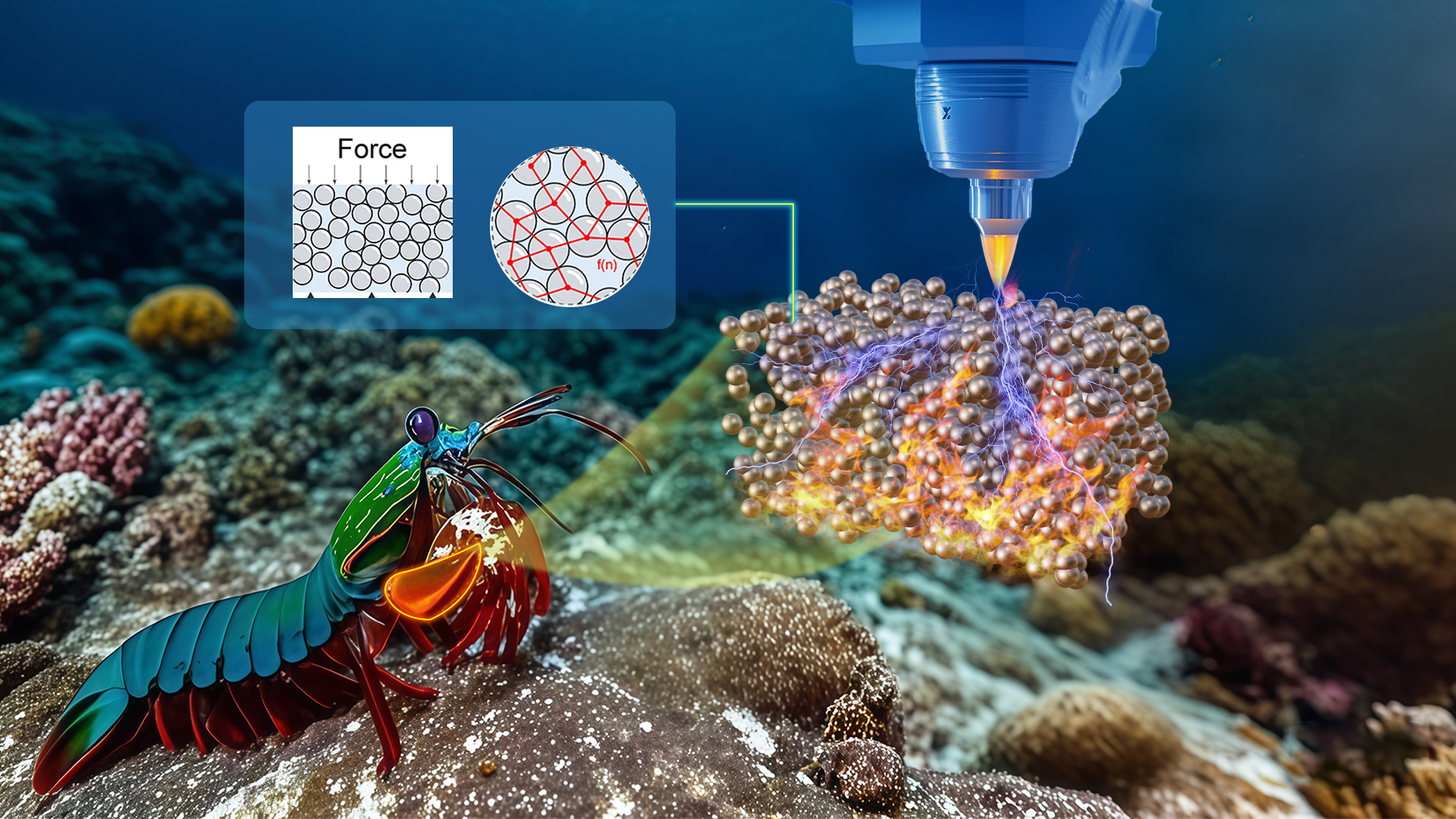
Inspired by the dense, highly mineralized layers on the surface of biological exoskeletons, such as those of the mantis shrimp, a research team from the Southern University of Science and Technology (SUSTech) has developed a 3D printing strategy using hollow glass microspheres (HGMs) as a model filler, achieving HGM content as high as 99.2 wt.%.
Their paper, titled “3D printing of ultrahigh filler content composites enabled by granular hydrogels”, has been published in Advanced Materials, a leading international journal.
The key to the team’s method is the introduction of highly swollen granular polyacrylic acid hydrogels (PAA) between the HGMs. These hydrogels act as a shear slipping phase, reducing the probability of nozzle clogging during the extrusion of ultrahigh HGM content inks. Following the printing process, the shrinkage of the hydrogel during the drying phase facilitates the dense packing of filler particles, resulting in a compact composite structure and improved printing resolution (Figure 1).

Figure 1. The preparation process of ultra-high filler content composites. a) Schematic diagram of the biomineralized layer on the surface of a mantis shrimp’s dactyl club. b) Schematic diagram illustrating the flow of HGMs (Hollow Glass Microspheres) and granular PAA hydrogels during the extrusion printing process. c) The printed HGM/PAA hydrogel shrinks after controlled drying, causing the internal HGMs to become densely packed. d) Scanning electron microscope (SEM) image of the HGM/PAA composites after shrinkage.
The researchers systematically investigated the printing performance of the composite inks and the influencing factors (Figure 2). By incorporating granular PAA hydrogels, stable extrusion was achieved even when the mass fraction of HGMs was as high as 99.2 wt.% (corresponding to 99.7 vol.%). They established a printing state phase diagram based on the filler-to-hydrogel volume ratio (V*) and the particle-to-nozzle diameter ratio (N*), providing quantitative guidance for clog-free printing. Using this strategy, they successfully printed fine lines with a minimum width of ~377 μm and dot-matrix structures of ~483 μm, validating the capability for stable printing with high filler content. A comparison showed this work achieved a higher maximum filler mass fraction than other 3D printing and non-3D printing techniques.
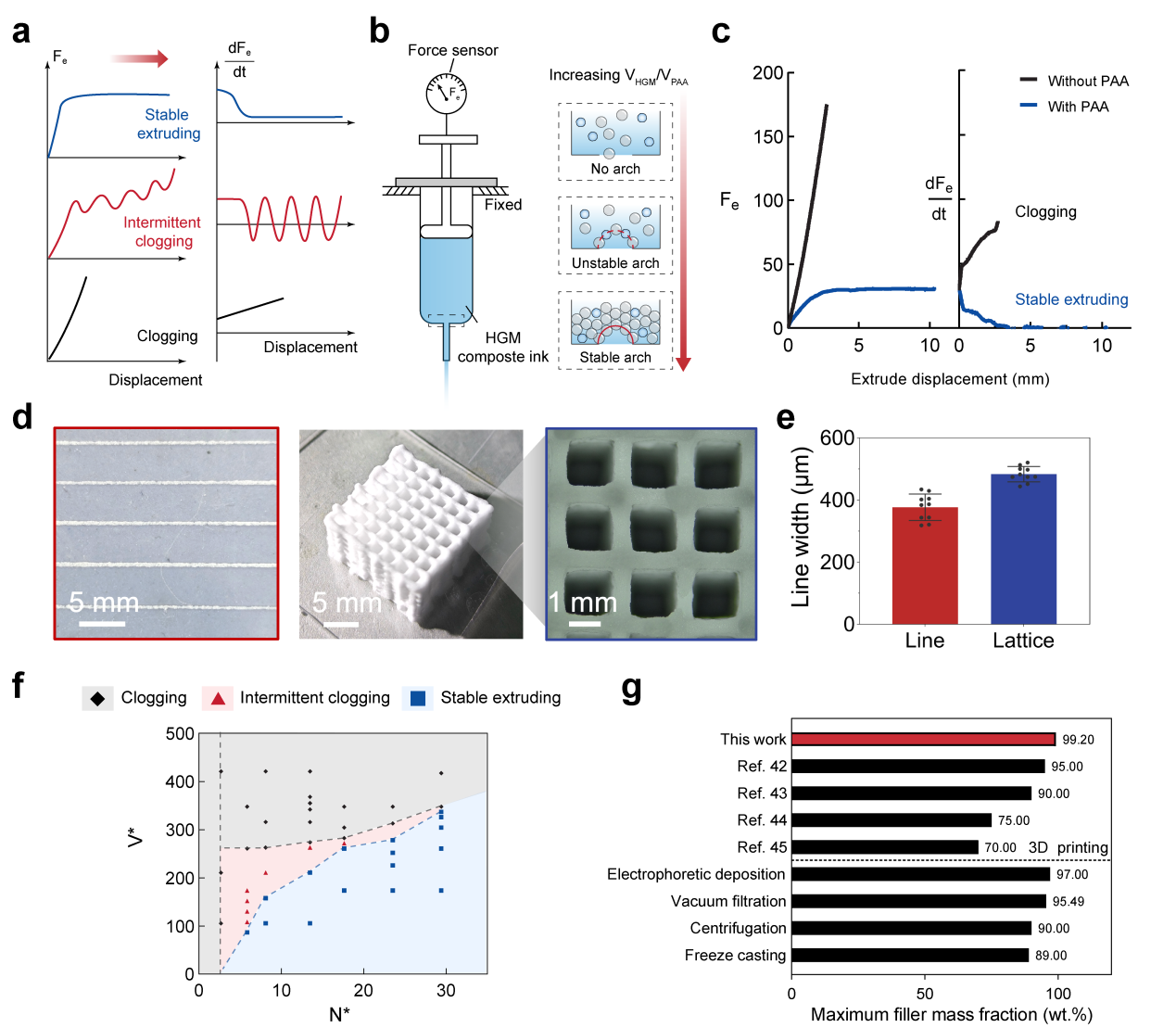
Figure 2. Printing state of inks with ultrahigh HGM content. a) Extrusion force change rate curves for three typical extrusion states. b) Schematic diagram of the extrusion force testing setup and the nozzle clogging mechanism. c) Improvement in the extrusion behavior of high HGM content ink by adding PAA. d) Photographs of the finest lines and dot-matrix structures printed. e) Linewidth statistics for the lines and dot-matrix structures. f) Printing state phase diagram as influenced by V* and N*. g) Comparison of the maximum filler mass fraction in composite materials prepared by this work with those prepared by other 3D printing and non-3D printing techniques.
The mechanical properties of the 3D printed ultrahigh filler composites were then characterized (Figure 3). Results indicated that the mechanical behavior, such as specific strength and compressive response, is influenced by the particle size of the HGMs and the HGM-to-PAA ratio. Composites prepared with smaller HGM particles exhibited higher specific strength. With increasing HGM content, the compressive behavior of the composites transitioned from being dominated by PAA polymer slip to being governed by force-chain networks formed between HGMs. However, if the HGM content became too high, the mechanical performance declined due to an insufficient polymer matrix to effectively bind the HGMs.
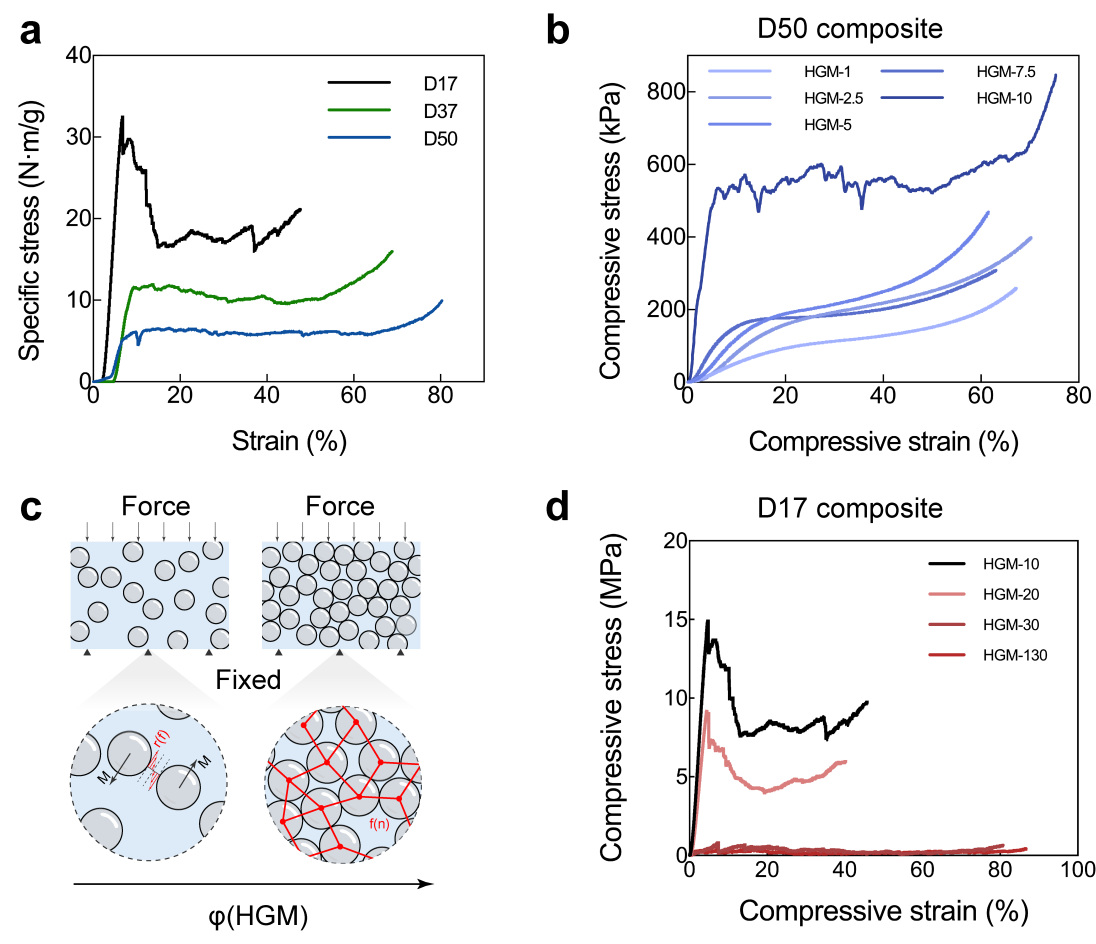
Figure 3. Mechanical behavior of ultrahigh HGM content composite materials. a) Specific stress-strain curves of HGM-10 composite materials prepared with three different HGM particle sizes. b) Compressive stress-strain curves of composite materials with different HGM/PAA ratios. c) Schematic diagram illustrating the transition in the compressive mechanical mechanism for high HGM content composite materials. d) Stress-strain curves of HGM-10 to HGM-130 composite materials.
Furthermore, HGM/PAA composites exhibited excellent electromagnetic properties (Figure 4). Compared to pure PAA, the HGM-10 composite showed a 14-fold increase in volume resistivity, and its corona resistance lifetime was significantly extended. In the K-band frequency range (18~26 GHz), the HGM-10 composite displayed a low dielectric constant (real part) of 1.12~1.13 and a dielectric loss tangent of 0.0024~0.0047, demonstrating outstanding wave-transparent properties with a maximum transmittance of up to 0.996.
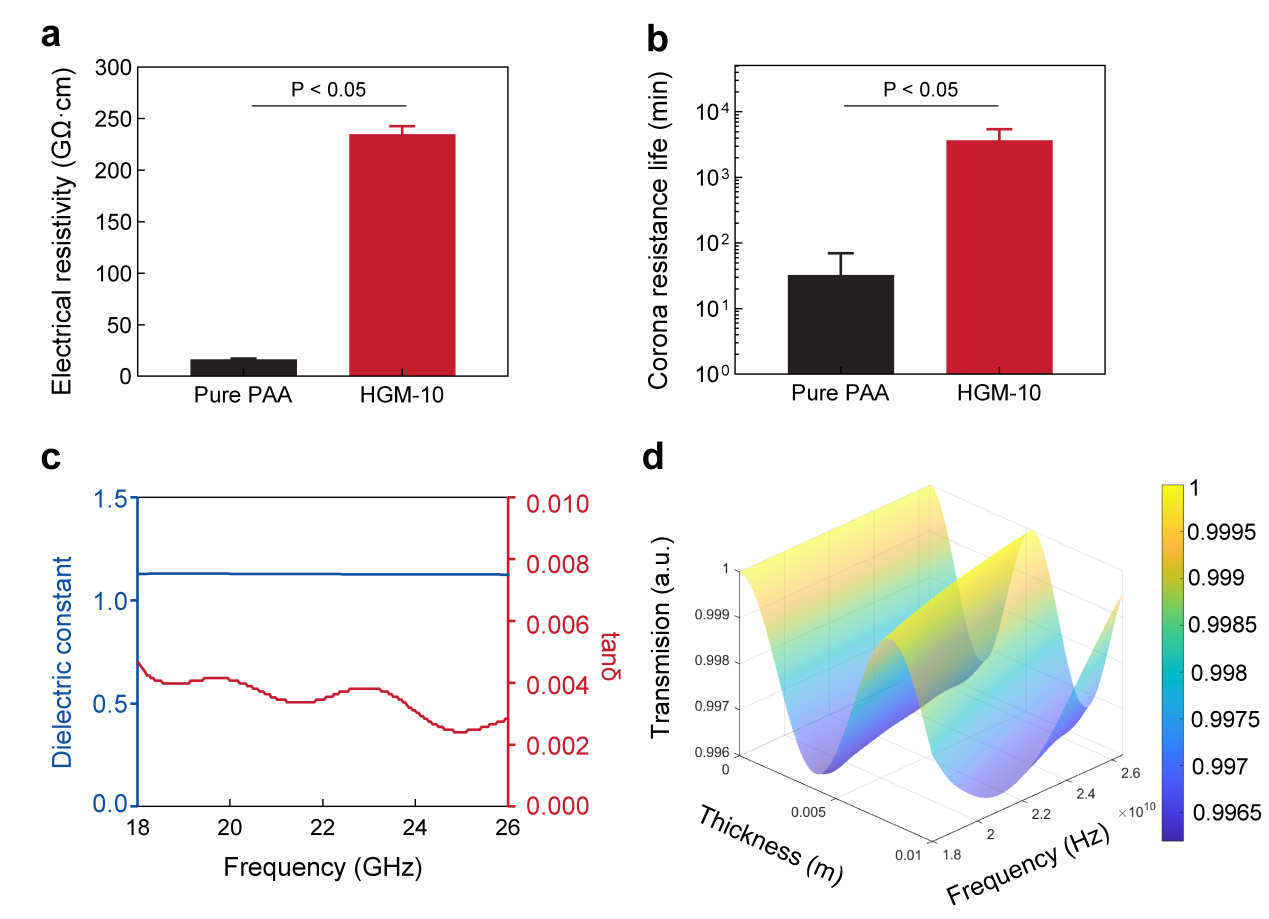
Figure 4. Electromagnetic properties of ultrahigh HGM content composite materials. a) Volume resistivity of pure PAA and HGM-10 composites. b) Corona resistance lifetime of pure PAA and HGM-10 composites. c) Dielectric constant (real part) and dielectric loss tangent of HGM-10 composites. d) 3D wave transmission map of HGM-10 composites.
These ultrahigh filler composites also demonstrated potential as efficient thermal management materials (Figure 5). Compared to pure PAA, the introduction of HGMs reduced the thermal conductivity of the composites by 72%~84%, with the thermal conductivity as low as 0.045 W m-1 K-1 at 25 °C. As a proof of concept, the researchers used this strategy to fabricate a thermal protection shield for specific areas of a microcircuit. After installing this shield, the temperature of the protected area was effectively controlled when the microcircuit operated under high load for two hours, creating a clear temperature difference from the surrounding areas.
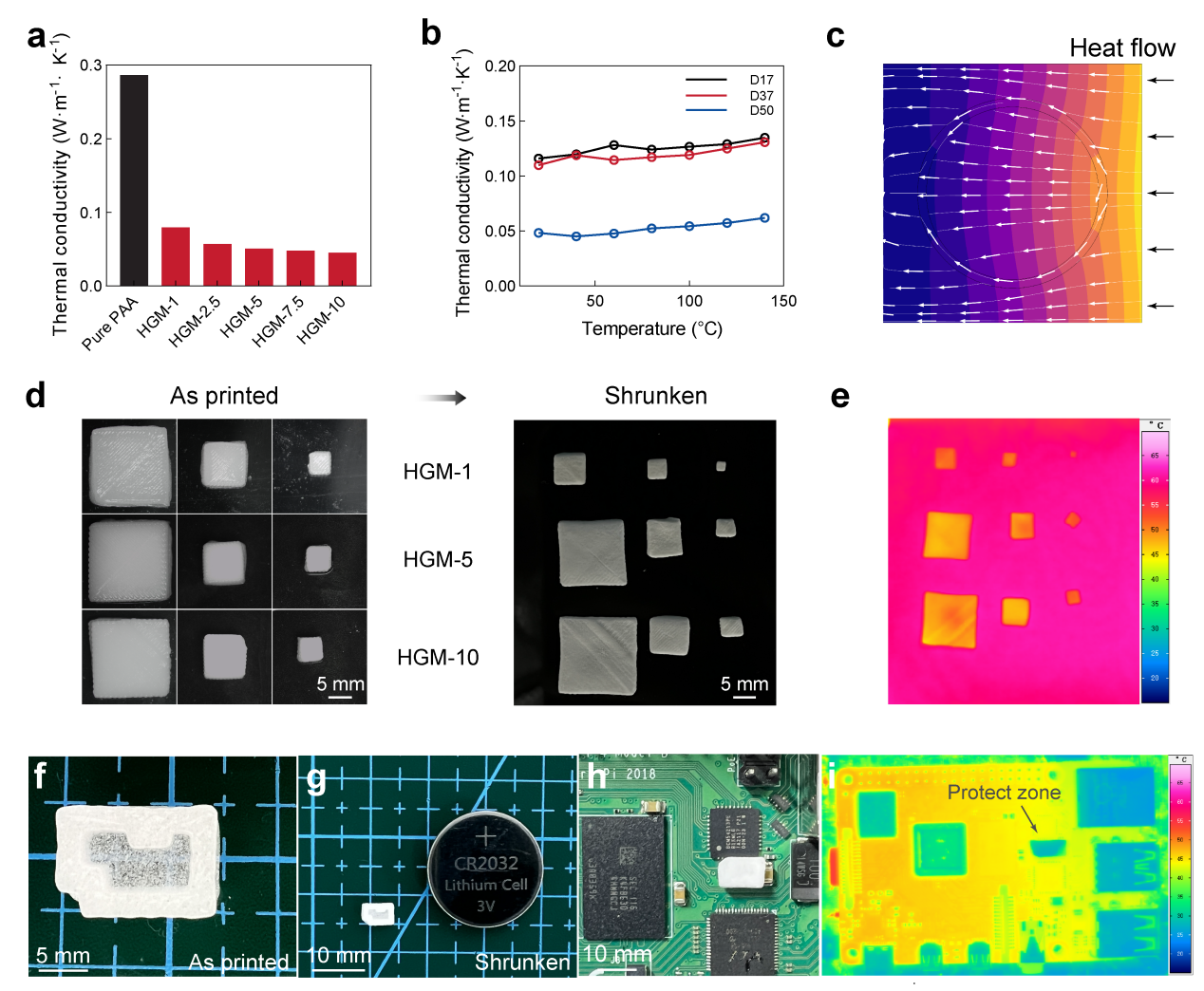
Figure 5. Thermal insulation performance and applications of ultrahigh HGM content composites. a) Thermal conductivity of pure PAA and HGM-1 to HGM-10 composite materials. b) Thermal conductivity of composite materials with different HGM particle sizes at 20 °C to 140 °C. c) Finite element method simulation of microscopic heat flux lines in HGM/PAA composite. d) Photographs of composites with different HGM contents in their as-printed and shrunken states. e) Infrared thermal image of dried composite material of the same thickness on a hot plate. f-g) Photographs of the thermal protection shield after printing and drying. h) Photograph of the thermal protection shield installed on a microcircuit board. i) Infrared thermal image of the microcircuit with the thermal protection shield installed after operating for 2 hours.
This study reports a 3D printing strategy successfully printing composites with ultrahigh filler content (up to 99.2 wt.% HGMs) that mimic dense biomineralized structures. The granular PAA hydrogel acts as a shear-slipping phase to improve ink flowability, while its shrinkage contributes to enhanced structural resolution and filler density in the final composite. This strategy opens new pathways for creating advanced 3D composites with high performance by fully utilizing the properties of functional fillers. It holds promise for applications such as thermal management for microelectronic devices, high-density solid-state battery electrolytes, and high-surface-area catalysts.
Postdoctoral researcher Chen Cui from the Department of Materials Science and Engineering at SUSTech is the first author of the paper. SUSTech is the primary and corresponding institution for this work.
Paper link: https://advanced.onlinelibrary.wiley.com/doi/10.1002/adma.202500782
To read all stories about SUSTech science, subscribe to the monthly SUSTech Newsletter.
Proofread ByAdrian Cremin, Yuwen ZENG
Photo ByDepartment of Materials Science and Engineering